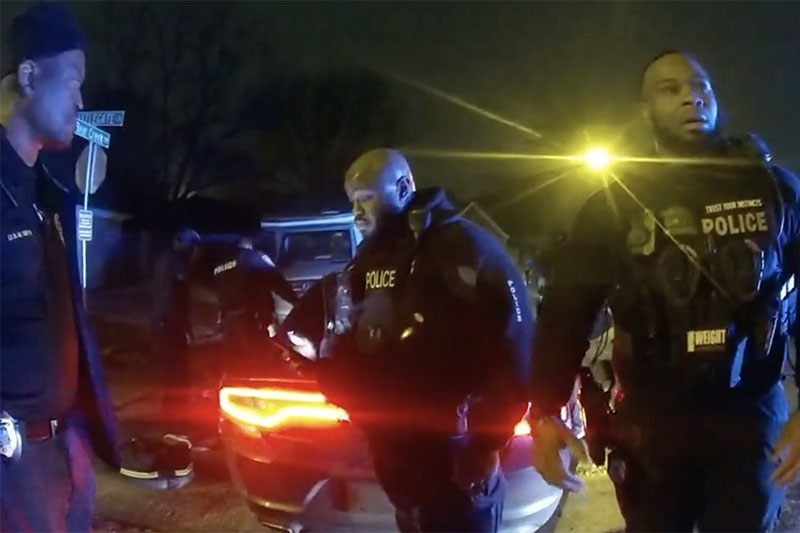Body camera and surveillance footage depicting the 7 January, 2023, fatal beating of Tyre Nichols was key in raising national awareness and prompting protests for police reform. It may now play a crucial part in any prosecution of those accused in his death.
Video does not provide a unified, objective window onto the truth. Rather, jurors may perceive the depicted events differently – based, among other factors, on how the video is presented in court.
Five Memphis police officers have been charged with murder and are set to appear in court on 17 February. Additionally, the US Justice Department has opened a civil rights investigation into Nichols’ death.
For over a decade, I have studied how video evidence has helped civil rights and human rights claims get recognition and restitution in the US and around the world. As a media scholar, I am especially interested in understanding the power and limitation of video evidence inside the courtroom, especially as video is now estimated to form a part of four in every five criminal cases.
I have found that video does not provide a unified, objective window onto the truth. Rather, jurors may perceive the depicted events differently – based, among other factors, on how the video is presented in court.
How video’s presentation can influence perception
Video can turn its viewers into witnesses, giving them the impression that they are transported directly to the event in question. Even judges may believe that the opportunity to see a video is equivalent to those in court seeing the real event.
In the words of one district judge, it is as if the court had “witnessed with its own eyes”. Yet a growing body of interdisciplinary research has shown that there are many influences on how people perceive events recorded on video.
The variations in the perception of intent were driven, in part, by the distinctive camera perspective. A body camera records from the police officer’s point of view, so it is unable to show the officer.
The speed at which video is played in court, for example, can affect people’s judgments. Videos played in slow motion, compared with normal speed, result in greater judgment of the intention of the person in the depicted action. Sports replays are an easy way to understand this point – slowing down events can make a foul in soccer or football seem more egregious.
Additionally, even the type of video people see can change their perception of what it shows. Across eight different experiments, viewers of body camera footage were less likely to judge the police officer as having acted intentionally than those who watched the same incident captured on a dashboard camera.
The variations in the perception of intent were driven, in part, by the distinctive camera perspective. A body camera records from the police officer’s point of view, so it is unable to show the officer. On the other hand, a dashboard camera is mounted on a police car, thus it can show the officer’s actions from a wider angle and not necessarily from their viewpoint.
Confirmation bias
The discrepancies in perception and the judgments that ensue from the type and presentation of video are significant: they can be highly consequential in a criminal court trial where intent needs to be proved beyond reasonable doubt.
Furthermore, these cognitive biases may be particularly pernicious to people of color within a legal system that already discriminates against them. The perspective of body cameras, for example, may worsen racial biases in viewers of videos depicting police use of force.
A study shows that white viewers perceived dark-skinned civilians more negatively than light-skinned individuals when the body camera made them the subject of primary focus.
Multiple viewing opportunities are ultimately unlikely to reduce biases that may already exist.
A common assumption is that repeated viewing can assist people to focus on information they may have missed on the first viewing, seemingly helping them better evaluate the depicted event. During trial, jurors indeed have multiple opportunities to see the same video.
However, an eye-tracking study demonstrates how people engage in visual confirmation bias: their eyes follow a very similar pattern of visual attention, making them overconfident about their initial perception of the video in question. In other words, multiple viewing opportunities are ultimately unlikely to reduce biases that may already exist.
The proliferation of video is therefore challenging the existing legal practices regarding its presentation and use in court.
Equal and fair justice in an age of video
The Bureau of Justice Assistance at the US Department of Justice estimates that video now appears in about 80% of criminal cases. Yet US courts, from state and federal all the way to the Supreme Court, lack clear guidelines on how video can be used and presented as evidence.
As a result, the US legal system provides substantial discretion in evaluating video evidence by ignoring a range of biases that may shape visual perception and judgment in court.
The footage of Tyre Nichols is yet another reminder that video can help people bear witness to traumatic events. However, the way video is presented in court can greatly influence jurors’ perceptions.
As more and more encounters with police officers that are proving deadly are making their way into criminal and civil courts, I believe, the legal system needs mechanisms that can ensure consistency and fairness in the presentation and evaluation of video as evidence.
This article first appeared on The Conversation, and is republished under a Creative Commons Licence; the original can be read here.
About the Author
 Sandra Ristovska is Assistant Professor in Media Studies at the University of Colorado Boulder, and studies the interplay between images and human rights, particularly in institutional and legal contexts. She has held the George Gerbner Postdoctoral Fellowship at the University of Pennsylvania, and visiting fellowships with the Information Society Project at Yale Law (where she was also an advisor to the Visual Law Project), the Institute for the Study of Human Rights at Columbia University, and the Center for Media, Data and Society at the Central European University. Sandra was the recipient of the 2021 Mellon/ACLS Scholars and Society Fellowship for her work on video evidence.
Sandra Ristovska is Assistant Professor in Media Studies at the University of Colorado Boulder, and studies the interplay between images and human rights, particularly in institutional and legal contexts. She has held the George Gerbner Postdoctoral Fellowship at the University of Pennsylvania, and visiting fellowships with the Information Society Project at Yale Law (where she was also an advisor to the Visual Law Project), the Institute for the Study of Human Rights at Columbia University, and the Center for Media, Data and Society at the Central European University. Sandra was the recipient of the 2021 Mellon/ACLS Scholars and Society Fellowship for her work on video evidence.
Picture © City of Memphis


